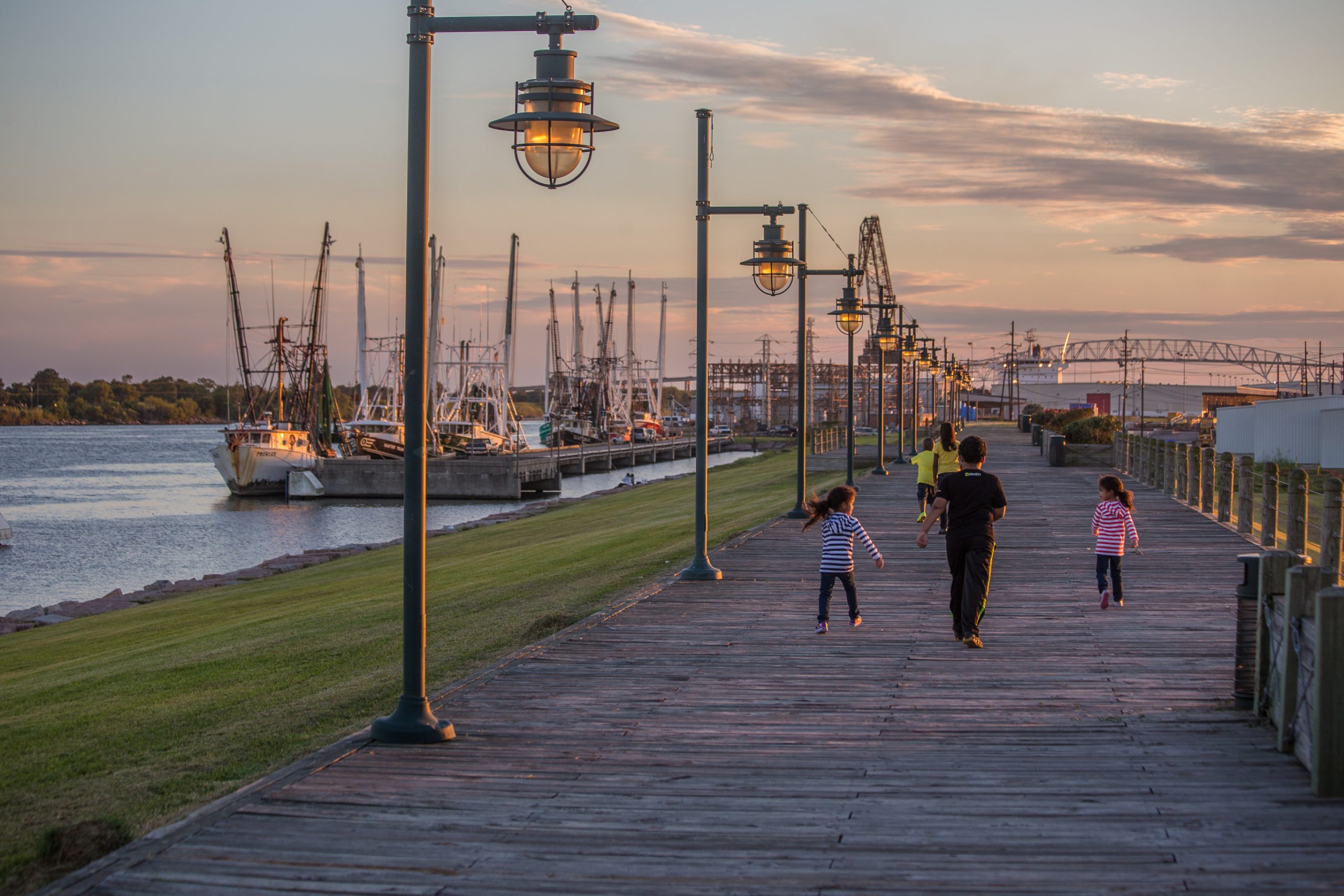
The boardwalk of the coastal city Port Arthur. Photo by Kevin Stillman
Port Arthur is known to some for petrochemicals, Gulf Coast hurricanes, and being the hometown of rock star Janis Joplin and Dallas Cowboys coach Jimmy Johnson. Now, the Texas Legislature has affirmed what longtime residents always believed—the southeast Texas city is the official Cajun Capital of Texas.
When the official designation was made at the end of the 88th Legislative Session in May, the city’s tourism bureau weighed in, proclaiming the city’s name should be pronounced “Port-Are-Ture,” invoking the French dialect of Cajuns who migrated from Louisiana and brought their customs with them.
“We are pretty much a Cajun family down here,” says Christian Manuel, the first-term state representative whose district includes portions of Port Arthur and Beaumont. “It is a prideful thing.”
Manuel, a Port Arthur native, introduced House Joint Resolution 61, one of eight resolutions that received approval for new special capital designations (see sidebar). “Celebrating 125 years of Cajun heritage … [o]ur vibrant community stands as a testament to the remarkable impact of Cajun traditions and culture,” he wrote on social media.
Ironically, Manuel’s shellfish allergy limits his Cajun diet to such alternatives as boudin and chicken and sausage gumbo. His family’s crawfish boils, a Port Arthur tradition, accommodate the allergy by adding chicken and potatoes to a spicy brew and setting his portion aside before throwing in the crawfish.
Another staple is Judice’s French Market and Cajun Deli, which opened in 1927. Manuel notes in his resolution that Judice’s “helped popularize such delicacies as crawfish, gumbo, and hot boudin.” He adds that in the 1960s, Gov. Preston Smith “tongue-in-check” appointed the merchant’s second-generation proprietor, A. J. Judice—nicknamed the “Crazy Frenchman” by locals—as the official commissioner of the sport of crawfish racing.
Of course, you can’t be a Cajun capital without music, so the resolution honored the late Harry Choates, aka the “Fiddle King of Cajun Swing,” and credited present-day artists like Donovan Bourque and Jude Moreau for “keeping the infectious Cajun rhythm part of the city’s soundtrack.” Bourque is a toe-tapping prodigy whose instruments were barely spared when his family’s home was destroyed by Hurricane Harvey, while Moreau is a veteran accordionist and bandleader whose early performances were nurtured at the Rodair Club, a popular Cajun dance hall mentioned in House Resolution 61.
Capital Gains
Here are the newest official state capital designations approved by the Texas Legislature and signed into law by Gov. Greg Abbott. The duration of such designations is 10 years.
• Cajun Capital, Port Arthur
• Celebration Capital, Granbury
• Dogwood Trails Capital, Palestine
• Peanut Capital, Floresville
• Rice Capital, Winnie
• Wellness Capital, Mineral Wells
In addition, the legislature extended a special designation of an area in metropolitan Dallas as “Koreatown Dallas” and designated Llano as “The Deer Capital of the Texas Hill Country.” Re-designations were given to Mansfield (Official Pickle Capital) and Bridgeport (Stagecoach Capital).
In his 2021 Texas Highways story surveying southeast Texas’ Cajun culture, Joe Nick Patoski wrote, “The easiest way to understand and appreciate a culture that isn’t your own is through its food and music. The Cajuns stand out on both fronts.” Asked recently about the new official Cajun Capital designation, Patoski responded, “That’s about right.”
Both Manuel’s resolution and Patoski’s story allude to the migration of French Acadians—who became known as “Cajuns”—from Nova Scotia to Louisiana in the 1700s, forced out of the Canadian province by the British. From the Louisiana backwoods, they emigrated to Texas because of the Great Mississippi Flood of 1927 and, just as likely, the promise of steady wages in the “burgeoning petrochemical industry.”
One tale about migration to the area described an effort to recruit workers for a new refinery in the early 1900s. According to a Port Arthur resident, who contributed to public comments on Rep. Manuel’s resolution, “Cajun French reverses the order of words, so the story goes, [and] they heard that a company in Texas planned to hire a million people to build a thousand-dollar refinery…That’s all they needed to know…so they came. By the thousands.”
Reflecting Port Arthur’s currently diverse population, the House resolution notes “residents of all backgrounds enjoy these distinctive elements of their [Cajun] culture.”
Thurman Bartie, Port Arthur’s mayor and the county’s first elected Black justice of the peace, agrees. “No matter what your ethnic background is, the Cajun community here connects you with that,” he told me over the phone. “We have a melting pot of citizens here in Port Arthur: Cajun, Black, Creole, Vietnamese, Hispanic, and even Native American.”
He recalled how even his own grandmother “made a mean gumbo,” using a black skillet to make the roux. “She put in crab, shrimp, and chicken and sometimes a little okra,” he said. “Also, we used to have what we called ‘poor man’s gumbo—sausage and chicken—when we didn’t have the seafood.”
Worth noting is the origin of Port Arthur’s name: It comes from a Midwesterner, not a Cajun. Arthur Stillwell planned the town on Sabine Lake as part of his scheme to connect Kansas City to the Texas Gulf with a railroad he founded in 1894. In his Texas Highways story, Patoski recounts this as when “the first Cajuns began moving across the Sabine River in the early 19th century,” with an 1850 U.S. Census counting 600 “Franco-Louisianans” in the region.
Cajun Celebration
Port Arthur celebrates its Cajun culture with the annual Cajun Heritage Fest in April. Sponsored by the Southeast Texas Arts Council, the event features Cajun and zydeco musicians, Cajun foods, and crawfish races.
Port Arthur shares its Cajun legacy with nearby towns. La Maison Beausoliel, a restored 1810 Cajun dwelling, can be found in Port Neches (it’s currently closed for repairs) and a replica of an Acadian home, La Maison Des Acadienne, is open for tours in Nederland, where live Cajun and Creole music jam sessions are frequently scheduled at the American Legion Hall. Larry’s French Market in Groves, founded by a third-generation Judice family member, offers a buffet of Cajun fried seafood and boiled crawfish six days a week along with live bands and dancing on weekends. Neighboring Orange County counted Cajuns as more than 30 percent of its population as late as 2000.
In the public comments for the resolution presented last May, Jim LaBove, an author and self-proclaimed Cajun preservationist, may have put it best: “The Cajuns were pilgrims in a strange land at first, but the salt marshes and the bayous around Port Arthur allowed them to continue their culture while they made a better living…Port Arthur is the only city in Texas that rightfully deserves to be designated as the official ‘Cajun Capital of Texas.’”
Editor’s note: A previous version of this article had Harry Choates’ name misspelled. We regret the error.








